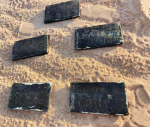You are here
Australia rules out swathe of ocean as MH370 crash zone
By AFP - May 29,2014 - Last updated at May 29,2014

SYDNEY — Australia Thursday ruled out a large swathe of Indian Ocean as Malaysian Flight MH370’s final resting place, compounding the frustration of passengers’ relatives who are still without answers almost three months on.
The Joint Agency Coordination Centre said a lengthy underwater search of an area where acoustic transmissions were detected in early April was now complete, as a US navy official queried whether the missing plane ever went there.
“The Joint Agency Coordination Centre can advise that no signs of aircraft debris have been found by the autonomous underwater vehicle since it joined the search effort,” JACC said.
It added that the Australian Transport Safety Bureau had advised that “the area can now be discounted as the final resting place of MH370” in an outcome that prompted anger and scorn from relatives still desperate for closure.
It also sparked a strong reaction from Chinese Premier Li Keqiang, who urged Malaysia to assign a new search plan for the missing jet.
“We expect Malaysia to take the leading and coordinating role, come up with a new search plan for the jet at an early date, and take the investigation seriously,” Li told Malaysian Prime Minister Najib Razak, who is on a visit to China, according to the official Xinhua news agency.
Nearly two-thirds of the passengers on the Beijing-bound aircraft were from China.
Australian ship Ocean Shield, which is carrying the US Bluefin-21 sub, has now left the area after scouring 850 square kilometres of sea bed for the jet that vanished flying from Kuala Lumpur to Beijing on March 8 carrying 239 people.
Re-examining the data
Australian Deputy Prime Minister Warren Truss said the search was concentrated where the pings were detected because it was “the best information available at the time”, without commenting on whether they came from the black box.
He added that Australia remained “very confident that the resting place of the aircraft is in the southern [Indian] Ocean”.
The US navy pinger locator, dragged by Ocean Shield, was used by searchers to listen for underwater signals in the remote southern Indian Ocean in an area where satellite data indicated the plane went down.
A series of signals it picked up prompted Australian Prime Minister Tony Abbott to say he was “very confident” they were from the black box, which led to the deployment of the sub on April 14.
JACC said the operation would now move to the next phase involving sophisticated equipment to scan the unmapped ocean floor, with all existing information and analysis reviewed to define a new search zone of up to 60,000 square kilometres.
A Chinese survey ship, Zhu Kezhen, is currently mapping areas of the ocean in preparation for the commercially contracted deep sea search, which is expected to begin in August and take up to 12 months.
Australia has previously said this work could cost A$60 million. It is not clear how expensive the search operation has been so far.
Scott Hamilton, managing director of US-based aerospace consultancy Leeham, said all the data would have to be re-examined “from start to finish” but he did not believe the search would be called off any time soon.
“I think it will be some time, perhaps years, before they completely throw in the towel,” he said.
Relatives frustrated
Many relatives of those on board have voiced frustration over the lack of progress and accused Kuala Lumpur on Wednesday of withholding crucial satellite data.
That came after Malaysia on Tuesday released a 47-page summary of communication logs from the plane recorded by British satellite operator Inmarsat, information relatives had long demanded.
“So much time has passed and nothing has been found, so we doubt that the calculated position of the plane is correct,” said Steve Wang, a spokesman for a support group of relatives of the flight’s 153 Chinese passengers.
Wang said comments Thursday by the Australian-led search coordination agency had left him seething.
“I am afraid that maybe some days later they will say that they no longer have clues about it, and we will search for more clues, but after that will stop the search,” he said.
“We do not trust Malaysia, and today, since they have made such a big mistake, we do not trust the JACC.”
Malaysia insists it is doing all it can in what is an unprecedented situation.
Relying in part on the Inmarsat data, officials believe the jet inexplicably veered off its flight path before crashing into the sea, possibly after running out of fuel.
Related Articles
The search for missing Malaysia Airlines Flight MH370 could take years, US Navy officials suggested on Sunday, as search and rescue officials raced to locate the plane’s black box recorder days before its batteries are set to die.
A new analysis of satellite data indicates the missing Malaysia Airlines plane crashed into a remote corner of the Indian Ocean, Malaysian Prime Minister Najib Razak said Monday.
The Australian agency heading up the search for the missing Malaysian jet has dismissed a claim by a resource survey company that it found possible plane wreckage in the northern Bay of Bengal.


















